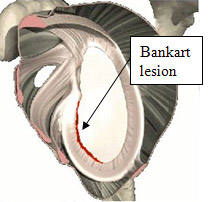Shoulder labral tears are a common cause of persistent and/or recurrent shoulder pain. They can be somewhat difficult to diagnose in that they can often act like other types of shoulder problems. In fact, labral problems can clinically look like rotator cuff pain, they can also cause mechanical sensations, they can resemble biceps tendon pain, and they can be associated with shoulder instability. So, lots of different types of shoulder problems can be related to problems with the shoulder labrum.
fact, labral problems can clinically look like rotator cuff pain, they can also cause mechanical sensations, they can resemble biceps tendon pain, and they can be associated with shoulder instability. So, lots of different types of shoulder problems can be related to problems with the shoulder labrum.
Anatomy
The shoulder is most easily described as a ball and socket joint. The humeral head (ball portion) fits within the socket of the shoulder which is a part of the scapular bone. The glenoid (socket portion) is, from a bony standpoint, fairly flat like a plate. So the ball portion fits onto a fairly flat structure. The labrum is a cartilaginous deepening of this plate into more of a bowl. The shoulder ligaments blend into this fibrocartilaginous structure forming the labrum that surrounds the socket. The ligament and labral structures deep to the rotator cuff, the rotator cuff helps dynamically hold the ball into this socket that helps provide stability of the shoulder joint.
This labrum can be damaged for several reasons. It can get caught between the ball and socket portion of the shoulder, and shoulder episodes that cause the shoulder to subluxate or dislocate can tear the labrum as well causing additional problems.
Causes
Labral tears can be caused either from a direct traumatic acute injury or it can be a part of a repetitive overuse type process. Again, more common representations are in a shoulder dislocation episode, when the ball comes out of the socket it will tear the labrum away from the glenoid, and sometimes this does not heal on its own. Additionally, because the biceps tendon attaches onto the top of the socket and blends with the labrum, overuse injuries involving overhead throwing or hitting athletes can cause this biceps tendon/superior labral complex to become unstable from the glenoid. This is called a SLAP lesion. Additional types of injuries to the labrum can happen posteriorly. Offensive linemen that have to do a lot of pushing against their opponents can cause the ball portion to push posteriorly leading to posterior labral tears. Weightlifters likewise can have a similar mechanism of injury.
Symptoms
Labral tears can cause a variety of symptoms. One can complain of mechanical symptoms such as popping and catching with certain types of shoulder movement. More commonly, labral tears cause pain. It just hurts, and it is often difficult to localize. When one treats common shoulder complaints, the labral tear can often respond to conservative management. However, it often will recur once the patient returns to their previous activity level. Those labral tears that are associated with instability symptoms are more obvious.
Diagnosis
Labral tears are most often suspected based upon the patient’s history. One may describe recurrent instability symptoms or pain that may initially respond to appropriate conservative management but
recurs. Certain sports or provocative activities may aggravate symptoms.
Additionally, physical exam maneuvers that are done in the office can help make this type of diagnosis. There are certain provocative maneuvers that are done that can clue us in that the pain from the shoulder is coming from the labral structure.
If this type of pathology is suspected as the cause of shoulder pain, confirmation requires a special type of MRI scan where dye is placed in the shoulder first and then the MRI scan is taken with the dye in place. This allows the dye to leak underneath the labrum between the glenoid and the labral tissue and allows it to be visualized on the imaging studies. Regular MRI scans often miss labral tears.
Certainly, if the labral tear has become symptomatic to lead to arthroscopic intervention, clear delineation of pathology is able to be performed with the arthroscope. Yes, sometimes the MRI scan and the clinical symptoms and physical examination can give one a suspicion, but this is not often completely confirmed until the time of arthroscopic surgery.
Treatment
Since labral tears can act like many other types of shoulder problems, they are initially often treated conservatively. That is, the patient is recommended to have activity modification for a period of time and often placed on oral antiinflammatory medications for a block of time. This allows pain and inflammation in the shoulder whatever reason it started ,to settle down. Once the inflammation in the shoulder has settled down and the symptoms have improved, the patient is often sent for physical therapy to teach them the core strengthening exercises for the rotator cuff.
Surgery is indicated for those symptomatic labral tears don’t get well with conservative management. Surgical repair of the labrum can be accomplished with minimally invasive arthroscopic surgery in the vast majority of cases. Anterior labral (Bankart) tears, superior labral (SLAP) tears, and posterior labral tears are all amenable to arthroscopic labral repair.
Video of Dr. Maffet performing arthroscopic SLAP lesion repair here and Bankart labral repair here.
